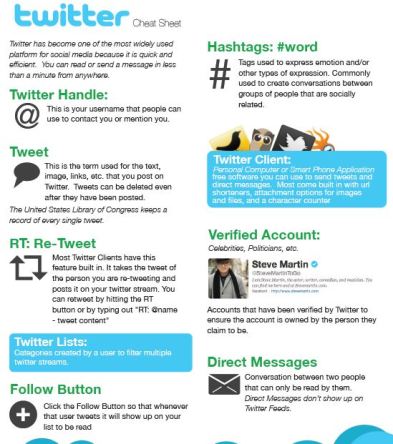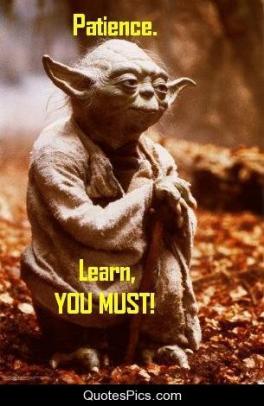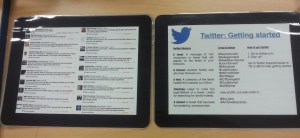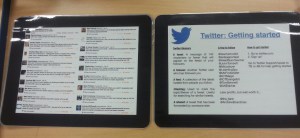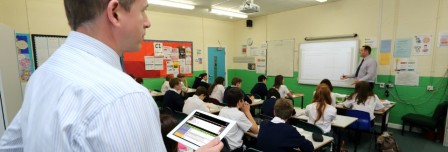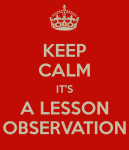Category Archives: T&L
Tweachers – My advice for starting out with #CupofTeaCPD Trilogy Part 2
I am quite happy to accept that I wasn’t the first. But since I posted my blog on why Teachers should use twitter, it seems that everyone started sharing theirs and to be fair everyone who has, pretty says the same thing.
It all equates to my new favourite phrase “Cup of Tea CPD”.
So, here are my Top 10 things to do if you are going to start up with Twitter. They are in no particular order, they are the things I have done and while I am no @TeacherToolkit or @LearningSpy or @LeadingLearner – I am pleased with my first forays into the whole chasm of Social Media.
10: Choose your identity carefully.
Choose a good handle, this is the name people will remember and associate with you.
Keep it short and memorable, it might be your name or what you do or stand for.
Be careful. I made two mistakes with mine: @WatsEd.
Firstly that is very close to ‘Wasted’ and secondly I have now lost count the number of people, who have assumed my name is Ed.
9: Make sure people can see you.
If you keep the ‘egg’, then it will put people off, add a profile picture, it need not be your face if you think it might scare away the internet (don’t worry though I haven’t been shunned for showing my face).
It will help your case if your profile looks real and human. There are a lot of fake accounts out there and if you want to make Twitter work for you, then be ‘present’.
8: Write a bio.
You have 160 characters available to you to say who you are and what you do or share some thing personal. Pets and children are popular, so is job title, hobbies and interests – whatever you like. This gives your follows and followers a chance to open dialogue with you and find common ground.
7: Choose your 1st 10 – 20 follows.
This bit is really important.
What do you want to get back from your exploration into the Twitter Jungle?
Pith Helmet on, rucksack and supplies at the ready, machete in hand (OK, perhaps not). Off you go.
Here are some people who would be good to get you started…
- @WatsEd (Well, I had to put me!)
- @redgierob (Rob leads at the Literacy Shed site)
- @grahamandre (Graham runs the Numeracy Shed site)
- @ICT_MrP (for all things iPad and Computing)
- @InspiredMind5 (Comics in Literacy and wider learning)
- @MichaelT1979 (Michael does a fantastic job with Curriculum 2014 resources)
- @LearningSpy (David Didau – a man with his finger on the pulse of education today)
- @alanpeat (Alan is an author and creator of brilliant iOS apps ‘Exciting Sentences’ & ‘Pocket Punctuation’)
- @bryngoodman (ICT leader/writer and knowledgeable fellow)
- @Mr_SJS (Teacher and author of ‘The Penguin Pig’, see @PenguinPigStory)
- @TeacherToolkit (Most followed teacher in the UK – a man who knows what he is talking about – T&L/Leadership)
- @SeanHarford (HMI and Ofsted’s National Director for Schools Policy)
- @BeyondBehaviour (Steve Russell tweets about Behaviour Management/Strategy)
- @rivierabenson (Chris teaches in France and tweets teaching and learning)
- @ICTmagic (Martin shares endless links to useful, interesting and addictive websites for learning)
- @ASTsupportAAli (Amjad talks leadership, SEND, English and TwitterCoaching)
- @gazneedle (Gary tweets Literacy and Maths – Primary AHT)
- @DeputyMitchell (Blogging/Quadblogging and EdTech)
- @TomBennett71 (Tom is ‘A Teacher who Writes’ ITT and Behaviour inc. TES)
- @beingbrilliant (Andy Cope is an author and happiness expert)
Well there is a selection of 20 – pick and choose – look at the lists of followers and follows and you will soon pick up a healthy list.
6: Contribute – Be brave & Say something
It is like writing when you were little. What shall I write first? How shall I start?
Say “Hello!”
Tell the world it is your first tweet – it doesn’t matter.
Have a look through the people you follow’s timeline – RT things you like, favourite things you really like. Reply to the things that interest you, ask a few questions.
If you say nothing and just lurk on the periphery then you will get nothing out of Twitter, if you want it to work for you, then you need to put a little something in. You’ll get some feedback.
Be seen.
Talk about what interests you, what you want to know more about, reflect on your own practice, ask for new ideas.
Use images and infographics – share useful things that you have on your computer, links, youtube videos. The better the range, the more interesting you will be to prospective followers.
Join in with other people’s conversations – they won’t mind (I haven’t upset anyone yet by butting in!) If you are thinking about something because of a tweet posted, then reply. You can get a chat going then and it gets to be fun.
Dive in, the water is fine.
Do consider what you say though, remember that this is going to be your professional face.
It was @gazneedle who said: “If I wouldn’t shout it in the playground, then I wouldn’t tweet it.” He is right.
Don’t troll, don’t be dismissive. Call people out on their ideas, but let them validate them if they can because that is the key to #CupofTeaCPD!
5: Know what things mean!
There are a lot of acronyms and jargon to wade through – much is common sense but this should help you along the way to begin with.
4: Use #hashtags
There are so many #chats to join in with. These are 30-60 mins of VERY intense tweeting about specific topics.
- #ukedchat
- #edchat
- #education
- #behaviourchat
- #SLTchat
- #headteacherchat
- #MLTchat
- #aussiEd
- #usedchat
- #whatisschool
The list goes on.
Many of these have the discussion topics chosen by the users. These all have an appointed day and time, so if you are prepared, you are good to go.
When you tweet to start with, include these #hashtags in what you say, people who follow them will get to see what you say and may well follow you or reply.
3: Share your website or blog address.
WatsEducation Blog – http://www.watseducation.wordpress.com
WatsEd Consultancy – http://www.wats-edconsultancy.moonfruit.com
Twitter is social media after, so if you have something to say – show people where to find it.
It is a bit like your Bio. It will allow people to see what your philosophy is, what’s on your mind, what motivates or concerns you, about education in general or perhaps a reflection on your own practice.
If you have something to sell – here’s a chance.
If you don’t have a blog – start one – you don’t have to do very much – but once you read others it will most likely inspire you to write something too.
2: Separate Personal and Professional
Not always as easy as it sounds.
If you are planning on using Twitter professionally, I suggest you keep your non-education stuff separate. It keeps things tidy and presents your professional face. Social Media is a way of tracking someone (Big Brother is watching – or is he!?)
Remember your colleagues and school leaders might be joining you – what do you want them to see?
I have found that very quickly, as I built up a PLN (Personal Learning Network) of like minded individuals that banter and in jokes do start, that’s OK, but if I was chatting with non-education people on the same timelines then it might get somewhat blurred.
Make a decision – in the end you can play it out however you like.
Decide what will work best for you.
1: Be patient
No, seriously. Be patient.
When you start you ca expect to get a little feedback on what you say. Perhaps even the holy grail of a Retweet (RT) or favourite. This is how people bookmark your tweets. The more that you say and do, the more interest you will develop and the more people will be inclined to follow you. Over the course of a few weeks/months the network will grow and you will find yourself drawn into more and more conversations and discussions.
Don’t let it take over your life (that is very easy, believe me!)
Be discerning about who you develop links with, some people will just be people you follow, some will be people you have occasional link with and then there will be people who form your PLN (Personal Learning Network) – you will realise who they are when they include your name in the tweets so you are drawn in, or they will refer to you when questioning or answering others, this is when Twitter becomes really powerful.
Now you have got yourself started, the learning can begin. I have been amazed at the wealth of knowledge, ideas and resources out there. I knew they would exist, but Twitter has shown me where to go to read about more and more interesting things.
I has both shown me how much I don’t know and need to learn and how much I do know and have been doing for years and even things I did and stopped doing for a variety of reasons.
Make your experience as broad and varied as you can.
Read blogs.
Share ideas.
The more you do people will want to know more about you.
Good Luck.
Enjoy the adventure, there are many others taking it with you and you can rest assured that you will bump into them on your way!
Update: 30-08-14
I have received this document as a result of these blog posts:
Essential Edchat Resource Guide
“This guide was brought to you by USC Rossier’s online EdD”
Hopefully you may find it useful.
Why should teachers be using Twitter? #CupofTeaCPD Trilogy Part 1
The reason for this post, is quite simply that it is self affirming.
I joined Twitter, professionally at least, in April 2014. I had been a Twitter non-user for a number years before that.
I didn’t get it.
Too little space, too little to read, too much nonsense, if no-one follows me what’s the point? No-one can read what I say.
As such, my profile sat, unloved, unappreciated and under used.
Then I had an epiphany (a late one, but better late than never!) I had realised it was something which could be used professionally and I knew a few people who used it, so I took the plunge and @WatsEd was born. Well created anyway.
Now 7 months later, I have Tweeted 10,622 times, I follow 1328 users (all real people too, not bots or rubbish) and am followed by 1137 users (also real people, I hope! They talk to me, so if they aren’t that’s worrying!)
I have learned more in that 5 months about what is happening in the world of education, than in the last 4 years!
- OfSted
- Curriculum
- Government Policy
- #Gove
- Tech
- App Development
- Blogging
- Leadership
- Global education
- Updates from Conferences
- Keynote Speakers
- Teachmeets
The list could go on and on.
I am not professing to be expert in any of these things, but I know things now that I didn’t before and that is an improvement.
Twitter has opened so many doors to my practice, self awareness and self reflection.
- Genius Hour (although I already did a similar thing)
- Flipped Classroom
- Raspberry Pi
- Educational authors.
All off this and more is at my fingertips – literally!
I can ask a question of my ‘Twitterati’ and within the day I will have answers, lots of answers, from people in different contexts who have a range of opinions – I can discuss them, argue my case, back down, stand up – whatever I need.
More CPD than I can handle!
——————————————————————-
So, to the point.
I want to share my new found obsession (and it can very easily become that!) with my own colleagues.
So I asked Twitter…
“I wonder if anyone has any materials for showing staff the benefits of Twitter?”
I had a few responses, all helpful, but it was Tom Bigglestone (@the_tank) who really came through.
He shared both his very lovely printed iPad handout complete with suggested user to follow and a collection of tweets answering the question: ‘Why should teachers use Twitter?’
His blog entry I re-blogged below is the rest of his 10 minute presentation to staff.
It was exactly what I needed – I could easily have written and said the same things, but sometimes it is nice to know that you aren’t alone in your opinions. That’s powerful.
Thanks Tom.
——————————————————————-
There are so many professionals out there in the ‘twittersphere’ and the ‘blogosphere’ – they are nice people and they are all too keen to share their skills, knowledge and understanding with anyone who cares to ask.
Where else can you discuss a chapter of a book with the author(s) over a coffee – almost anytime you like?
What about discussion about an app that you like, with the developer and coder? It’s brilliant.
If you are a teacher and you aren’t on Twitter – why not?
I have had what I now refer to as ‘Cup of Tea CPD’ so often.
Just make a cup of tea, ask the question and discuss. 15-20 mins and you know more, or you have shared with someone else. Brilliant.
There are so many #chats to join in with – 30 mins of VERY intense tweeting about specific topics. #behaviourchat, #SLTchat, #headteacherchat, #MLTchat, #edchat, #ukedchat, #AUSSIEdchat, #usedchat, #tlap, #whatisschool – again the list goes on. Many of these have the discussion topics chosen by the users. These all have an appointed day and time, so if you are prepared, you are good to go!
Two screens is helpful to track discussions.
Sometimes it is like being a kid in sweet shop!

Image from http://www.choosewoodbridge.co.uk/
I have wholeheartedly bought into the idea that Twitte can provides some of the best CPD you can get.
Update: 30-08-14
I have received this document as a result of these blog posts:
Essential Edchat Resource Guide
“This guide was brought to you by USC Rossier’s online EdD”
Hopefully you may find it useful.
Update: 02-09-14
This tweet makes me very proud.
A genuine 1st tweet using #CupofTeaCPD
https://twitter.com/primaryteachni/status/506877709923155969
Update: 04-09-14
Another 1st Tweet from my #CupofTeaCPD blogs
https://twitter.com/HayleyPreston8/status/507301255497388032
On Friday morning I gave a ten-minute briefing to all staff at my school on the benefits of Twitter for teachers. Accompanied by a keynote presentation behind me, I used the words below as a rough script (though I don’t tend to read from notes when presenting). I also had designed and laminated a double-sided cardboard ipad for all to take away: on one side was a collection of replies I received to the question ‘Why should teachers be on Twitter?’ and a Getting Started guide on the other.
Please feel free to use any of these ideas to “put the case” for Twitter among your colleagues.
“This briefing is on the benefits of Twitter for teachers, and why the fact that only 4% of teachers are on Twitter means there are so many missing out on its advantages. This is not a “how-to” use Twitter. If I what I say…
View original post 547 more words
What’s the value of that visit? (Part 1)
This post is the first one relating to ‘Wats-Education’
Wats-Education is a start-up Educational Consultancy. We aim to offer high quality support and advice for Sites, Venues and Visitor Centres to improve and develop planning, activities and environments for learning for educational/school visits and commercial public visits.
With our collective experience of almost 40 years as education professionals, teachers and school leaders from Early Years to Key Stage 2, we are well placed to work with clients to develop exciting new or existing environments.
We also have additional specialism in understanding and developing access arrangements for Special Educational Needs and Disability.
Having worked in education for many years, we have been on countless educational visits, some fantastic, others that have left us a little flat and disappointed. On those occasions when we have found ourselves saying; “This is good, but it would be even better if…” we realised there was an opportunity to offer our experience to help.
We want to help improve planning, access and variety of experience either to existing environments or to help develop new attractions, both for marketing within Education sector or for commercial public events and visits.
——————————————
On the 6th of May this year I started a survey of teachers and educators to discover the motivation for the inclusion of Educational visits in the curriculum. I felt that while it seemed obvious, I didn’t want to fall into the trap of making assumptions.
I had my own clear opinions and was interested to see whether or not others shared my views or if there was more to it. The survey was responded to by teachers from Primary (inc. Early Years), Secondary and Special schools from across the UK and one from a home educated family. Some teachers from overseas also responded including a small number from New Zealand, Australia and Canada.
There were 10 questions:
- Why do you include educational visits in your curriculum?
- What do you look for in an educational visit?
- What do you think is the most important factor for a successful educational visit?
- Where do you find out about potential venues/sites/centres for educational visits?
- In no more than 30 words, describe the best out of school learning experience you have shared with children.
- In no more than 30 words, describe the worst out of school learning experience you have shared with children.
- Is it important to you on an educational visit, that the venue is well prepared for your visit and has contingency for unforeseen events?
- Should venues have a selection of different contextual activities for children or do you think it is acceptable to focus on one specific activity?
- If you could guarantee one outcome of an out of school learning experience, what would it be?
- What would make you decide to make a return visit to any given venue, either annually or otherwise?
The survey closed on 22nd June.
The Results:
Why do you include educational visits in your curriculum?
(This question allowed more than one answer)
85% of respondents said that the main reason they included visits was to give children experiences beyond the classroom.
62% said that it was to provide fun/engaging topic starter/closer.
61% backed this by saying that it was to give children that ‘something extra’ that school cannot provide. WOW Factor.
There were other responses but these were the most significant. I don’t think that there are any surprises here. The purpose is surely to get children interested and excited about a topic/theme/idea. I am not sure that anyone would argue that these are some of the key reasons for taking children out of school to do something that will excite them and either set up their learning experience or consolidate it. While it seemed obvious, it was good to see the statistics match up.
What do you look for in an educational visit?
(This question allowed more than one answer)
70% of respondents said that Hands On activities were top of their priority list.
63% said Value for Money
49% On-Site resources and pre-planned/prepared activities
All this seems reasonable. Value for Money is a tough one to quantify. In my opinion that mean that each child comes away having had an experience that makes it worth the time, effort, planning and cost (let’s not forget that often families have to make their ‘voluntary contribution’). They come away with something they can actually use as part of their learning.
What surprised me was that ‘Expert Knowledge’ was the lowest factor when looking into an educational visit (35%). Also low was the Learning Environment itself (38%). I personally think a venue should look ready and be prepared for its guests. This is of course contextual. A beautiful sparking, neat and pristine farm, looks wrong, but an untidy, badly arranged and poorly organised museum is also not up to the job.
What do you think is the most important factor for a successful educational visit?
(Only one answer allowed)
I was surprised at the outcome of this question as it related so closely to the previous one.
When pushed to only give one response, the Learning Environment came out as the most important single factor for a successful visit (23%). So perhaps we do want to take our children to places which are prepared, set up, organised and ready for the visit with plenty of materials and resources available to support the context of the visit, much like we do in our schools and classrooms.
Hands On activities were again an important choice (19%) and an experienced and professional delivery by on site staff (15%) completed the top 3 factors for making a visit successful.
Some of the best visits I have been on have been made by the people we meet, some of the worst the same. If children meet someone who can engage and excite them, it will set them up for the whole experience. When they are by a tired and bored looking individual, who cannot wait to go home, the experience is ruined. All venues and sites which run visits for educational purposes should be sure that their staff are fit for purpose (and most definitely are).
Where do you find out about potential venues/sites/centres for educational visits?
(This question allowed more than one answer)
I didn’t expect any shocks with this question. Let’s be honest, as teachers there are three main ways of finding somewhere to take children. We know a place because we have been before, a colleague has been and told us how good it was and because we googled it!
These were overwhelmingly the top 3:
78% Web Search
70% Personal/Family visit
70% Professional Discussion/Dialogue
Social Media came out at 23%, so perhaps this is no the tool for professional discussion and dialogue. As more and more teachers and venues take to social media perhaps there is greater and greater opportunity for people to share opinions.
All types of written media (Local and Regional Newspapers, Tourist Information) were not a place for teacher to find ideas for visits, nor were random generic emails (10%).
This tells me that the best advertisement is a good experience. If you can deliver that and send people/children/teachers away happy and you will get more business. Teachers talk to each other and we like a recommendation!
——————————————
I will leave Part One here now and return to it at a later date where I will look at the written feedback from Best and Worst visits, why they were or were not successful and what can be learned from this.
If you have any questions on this post so far, please feel free to comment and share.
OfSted and NQTs – Who watches the Watchmen?
The following for those who haven’t already read the article is from The Guardian 04-06-14:
Posted by Michael Allen and Lucy Ward Wednesday 4 June 2014 15.56
From Monday, Ofsted will send inspectors to inspect trainees’ teaching in the autumn term as they start work as newly-qualified teachers.
Previously, Ofsted only inspected trainees in the summer of their training year. But the aim of the new plan is to ensure that new teachers implement what they have learnt while training in the classroom, particularly in managing behaviour and instilling discipline.
In a further change, inspectors will also judge whether teachers are dressed professionally and demonstrate professional conduct. While the inspectorate says it is not laying down a prescriptive uniform – ties will not be compulsory, it insists – it argues teachers should be dressed “in a way that befits their professional status”. Training providers who do not ensure trainees dress appropriately will be marked down.
Some teacher training providers have not prepared trainees adequately for their induction year, according to Ofsted. In a speech in January, chief inspector of schools in England, Michael Wilshaw, said Ofsted had “not been as demanding as it should have been with training providers who have sent newly-qualified teachers (NQTs) out into schools unprepared for the rigours of the classroom.”
Ofsted is particularly concerned that 40% of new teachers leave the profession within five years, with poor pupil behaviour cited as a key reason. The figure is a “national scandal”, Mr Wilshaw has said.
Sean Harford, Ofsted national director for initial teacher education, said the new two-stage inspection process would help raise standards, with further visits scheduled for those teachers needing support to improve. “Teaching is a tough yet very rewarding job. So it is important that the training new teachers receive is the best it can be. Trainees should learn how to promote good behaviour in the classroom so they can focus on teaching, and children and young adults can focus on learning.
“Through our new two-step inspection process we will make sure that teachers are putting into practice in the autumn what they learned in their training. I expect this new way of inspecting will help to raise standards. When we judge providers to require improvement or are inadequate we will support and challenge them to improve; we then will re-inspect them the following year.”
When judging teacher training providers, inspectors will now also have to evaluate how far they have tried to engage schools and colleges in challenging circumstances, including those deemed to require improvement, in training partnerships. They will examine whether teacher supply has increased as a result, particularly in areas of the country where recruitment is difficult.
———————————————————
So, in September OfSted will be specifically inspecting Newly Qualified Teachers to ‘ensure that they are applying their classroom learning of behaviour management and instilling discipline’. This will include professional dress and conduct.
Here’s an idea:
Let’s inspect and scrutinize some of the most vulnerable teachers, NQTs, you know the ones who need help and support to succeed in an incredibly challenging job.
Just as you start and before you can really secure your place – we will come in and check you are dressed right, speak right and can ‘deal with the pressures’ – that we have imposed.
I suspect there might even be a check that fingernails are clean and clipped and that hair is regulation length.
OK, so perhaps gold spangled hot pants are not quite right, but who is deciding? This has the potential to promote some very shallow values. Teachers should wear dress that ‘befits professional status’. This is incredibly subjective.
Where will they stand on tattoos and piercings?
Are ear-rings OK? For men and women?
What about a nose stud? Will that make someone an ineffective teacher?
I have tattoos, not visible and very small, but I know someone with a large tattoo on their arm.
They cover it, but it has been seen.
Is that ‘Inadequate’, Grade 4 dress or conduct? I think not.
This guy does a remarkable job promoting anti-bullying and anti-prejudice in schools – Michael Wilshaw would faint!?
I know another teacher who wears their PE kit, every day, whether or not they are teaching PE, does that mean they are not dressed in a way which befits their professional status?
As a recently qualified teacher some years ago, I experienced my first inspection. The Lead Inspector toured the school with the Head Teacher and commented to her something I have always remembered and admired:
“You have sure a wonderful range of individual teachers in your school. From the very experienced lady in Nursery to the young man with all the jewellery and bracelets (that was me by the way), it is lovely that your children get to see a variety of personalities.”
So, my wearing of 7 rings and 5 bracelets didn’t concern him, he liked it. Would this new regimen perhaps have frowned on it and ‘marked my training provider down’ for not teaching me what to put on in the morning?
I’m not sure that my College Tutor would’ve had the inclination to scrutinise my wardrobe.
I struggle to begin to express how terrifying this whole process is becoming.
In what sense does it help?
Mr Wilshaw tells us that:
‘…training providers have sent NQTs out into schools unprepared for the rigours of the classroom…’
We all know this.
NQTs know this.
Having your own class for the 1st time is terrifying. It is the first time that YOU are responsible for setting the climate for learning and not just adapting yourself into one that is already set by a teacher/school during your placements. It takes a little time. It is tough. We learn and we are taught by experienced colleagues, it is what we do and the vast overwhelming majority get it right.
Trainee teachers are not taught a great deal about behaviour management. That is why so many cite it when they choose to leave. I never found that learning about the work of child psychologists helped me very much – I know my Maslow, but have never really felt it was a tool for my practice.
Teachers don’t learn to be good at classroom and behaviour management in a tutorial or lecture. They do it through experience. If they are lucky they learn from good and outstanding teacher mentors during placements and from their colleagues in school. But it often takes a little time to find a way that works for the individual and develop a range of strategies which suit a range of different pupils.
We encourage children to make mistakes and build resiliency from it – but teachers don’t seem to be permitted to do it.
We take risks in being innovative with teaching methods and with new technologies and all is well, but if something doesn’t work there is the risk that if you are seen to go wrong – you have a problem and this absolutely should not be the case.
Sean Harford says that ‘…this will help raise standards…’.
Is this because OfSted is held in such high regard and that the teaching profession has so much faith in it?
If we want new innovative teachers to stick around – let’s support them. Let’s teach them, not scrutinize every move. That is why they leave!
Imagine if you will… it is Week 2 in September… OfSted are coming to inspect, not your school, but you.
Are you excited and looking forward to the prospect?
Or
Are you filled with self-doubt, because now, it isn’t just about you, but your school, your job, your colleagues…?
Pressure?
Seems a little harsh to me.
If ‘poor pupil behaviour’ is cited as the primary reason – is this being addressed in ITT? And not just through relentless Ofsted edict.
Let us not say the pie tastes bad, when we haven’t carefully judged what the cook put in.
If the recipe is wrong, the food will taste bad.
Improve training on understanding pupil behaviour and managing it, then we can perhaps alleviate the pressure put on new teachers by preparing them for the real world inside their own classroom.
I have written about this before:
https://watseducation.wordpress.com/2014/05/28/i-know-wwi-was-100-years-ago-but/
I worry that this design will not stem the tide of new teacher leaving within 5 years, it might make it 5 months!
What the teaching profession needs is a regular influx of new minds, fresh ideas and innovation.
While this is not provided solely by newly qualified teachers, they are a source of it and the NQTs of today are the Headteachers and School Leaders of tomorrow. They have enormous value. Why do we seek to undermine, under value and over scrutinise before they have had chance to show what they are capable of?
———————————————————
I would really like to know what are other peoples opinions on this.
Mike
A reflection on ‘How would you like to be observed?’
Another reblog, yes, I know, sorry.
http://teachertoolkit.me/2014/05/28/how-would-you-like-to-be-observed-by-teachertoolkit/
I am all for (sort of) a criteria driven observation, but not for a ‘Handbook’ method.
One size does not fit all, and no, not under any circumstances should there be a favoured teaching style.
When I have observed my peers, or they have observed me, those are the times when I feel that I have benefited the most as both the observer and observed.
As I said in the first post on this blog, “I am a teacher. I like to think that I am a good one at that – not spectacular – effective.” I have worked with and still do work with some exceptional teachers, people who I admire hugely and have had the pleasure to have told them that. When they visit my classroom and tell me what they felt worked well, I appreciate it and above all, I believe it. When they tell me what they think could have improved it, I am inclined to try it, quickly, because I trust them.
The current OfSted model doesn’t inspire that type of instant step-change of improvement, but it does expect it and woe betide those who do not deliver. Teachers in RI schools and being visited by HMI can testify to that I am sure. The inspector wanders in and out. They then categorize what they have seen and what it means for children’s learning. What about the child who is observed on Tuesday and Wednesday, but makes ‘no visible’ progress. On Thursday, when the inspector has shuffled off to wherever they shuffle off to, has assimilated all that information and experience and can do it, with confidence. No-one saw that. A jury of my peers, however, will be able to appreciate that measure of progress.
A few quotes from #sltchat (01/06/14):
- Wonder Academy @Wonderacademy: #sltchat No one can enter a room and evaluate progress, effectiveness of teaching or understand context of lesson in 20 minutes.
- Stephen Tierney @LeadingLearner: We mustn’t become dependent on OfSted for info about QoT. This should be our domain as schools and teachers – we should take lead #sltchat
- Urban Teacher @urban_teacher: Lesson Observations is only part of the picture – A grade doesn’t develop a teacher but genuine support & mentoring does!
I like the idea of schools in networks sharing staff, peer to peer work, based around specific focuses. Where there can be an open dialogue and discussion between teachers who can in turn learn from each other and their surroundings. There is also a strong case for visiting teachers not only who are held up to be leaders in their field but those who perhaps need support. You can learn much in either environment.
I want to get better – that is my aim.
I do this not by external judgement, I do this by continuing to learn.
There are many teachers I know who still cling to the ‘judgement’.
“He said it was GOOD, so I’m alright.” or “Requires Improvement?! Rubbish, what does she know?!”
I feel for them, if they decide they are alright, what is next? How precisely do they intend to improve?
I like it when someone visits me and gives me clear and honest feedback, I like that culture. Those formal and informal comments about anything that goes on, followed by, “Have you thought about…?”, ” I read that…” I don’t necessarily need to be given a label as I once did.
It comes to the culture of leadership and development.
What do we as teachers want from observation? Validation or Development.
If it is the first, then we might have an issue, but if what we really want and need, if what we can convince SLT (like me) and governors, LA and OfSted is that we just want to be better tomorrow than we were yesterday we might get somewhere.
We might do it smiling too.
@johnpearce_jp: (07-05-14)
Judgement without action is thinking without doing.
Reflections on – ‘No hands up nonsense’
I came across this post at
I think it encapsulates my feeling precisely.
I have used the technique on and off for a while and have decided to stick with ‘off’.
Sometimes I might get children to discuss and feedback – but I say who feeds back and they have to show a degree of understanding rather than ‘parrot’ a more able child’s response.
As teachers and educators, sometimes beware the policy shift from on high!
A good and outstanding teacher knows very well how to direct and differentiate questioning at a variety of levels to support pupils understanding. To blindly say “No hands up, means a) those who do have to find an alternative and b) those who don’t continue.
A teacher who doesn’t ever ask a child whose hand is down, is doing something wrong. In my opinion, I value seeing the force of hand raising to gauge confidence. I like to ask a child, “Is that half a hand up?” or “You’re really sure aren’t you?” or even “Why did you put your hand up, then take it down?….No, go on, what were you going to say?”.
Those are the questions which show children it is fine to be wrong sometimes and that a wrong answer is really valuable.
‘NO HANDS UP!’ Oh Please?!
Over the last few years, I’ve become aware of schools that have policies of ‘no hands up’.
To be clear, these are policies. Hence teachers are to some extent effectively banned from allowing pupils to put their hands up in lessons.
Pupils can’t put their hands up:
- because they are indicating know an answer
- because they want to answer a question
- because they agree/ disagree with another answer
I presume pupils are still allowed to put their hands up to ask a question or to ask for help, but I’d hazard a guess that this is somewhat confusing.
This is the kind of nonsense that comes out of a healthy instinct to try to stop pupils from opting out, then it gets taken on by management and suddenly, ludicrously, turned into a policy. The idea is that if a teacher asks a question, pupils will ‘think/pair/square/share’. They are supposed…
View original post 440 more words






